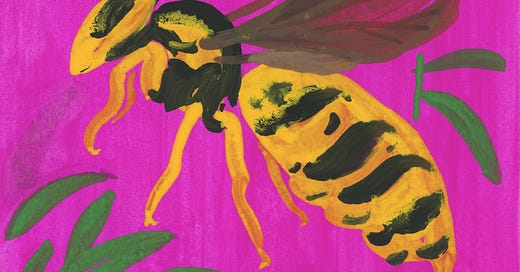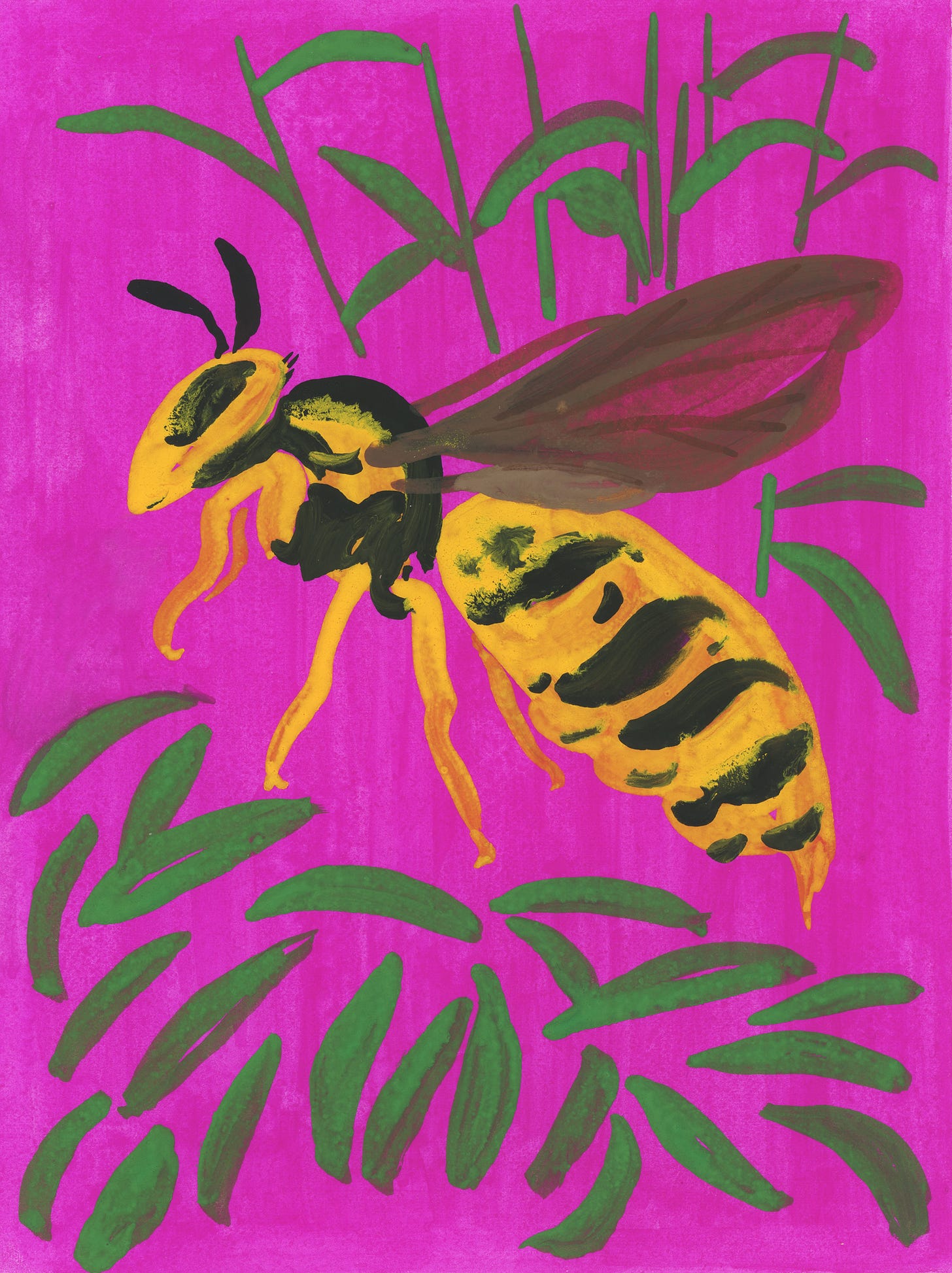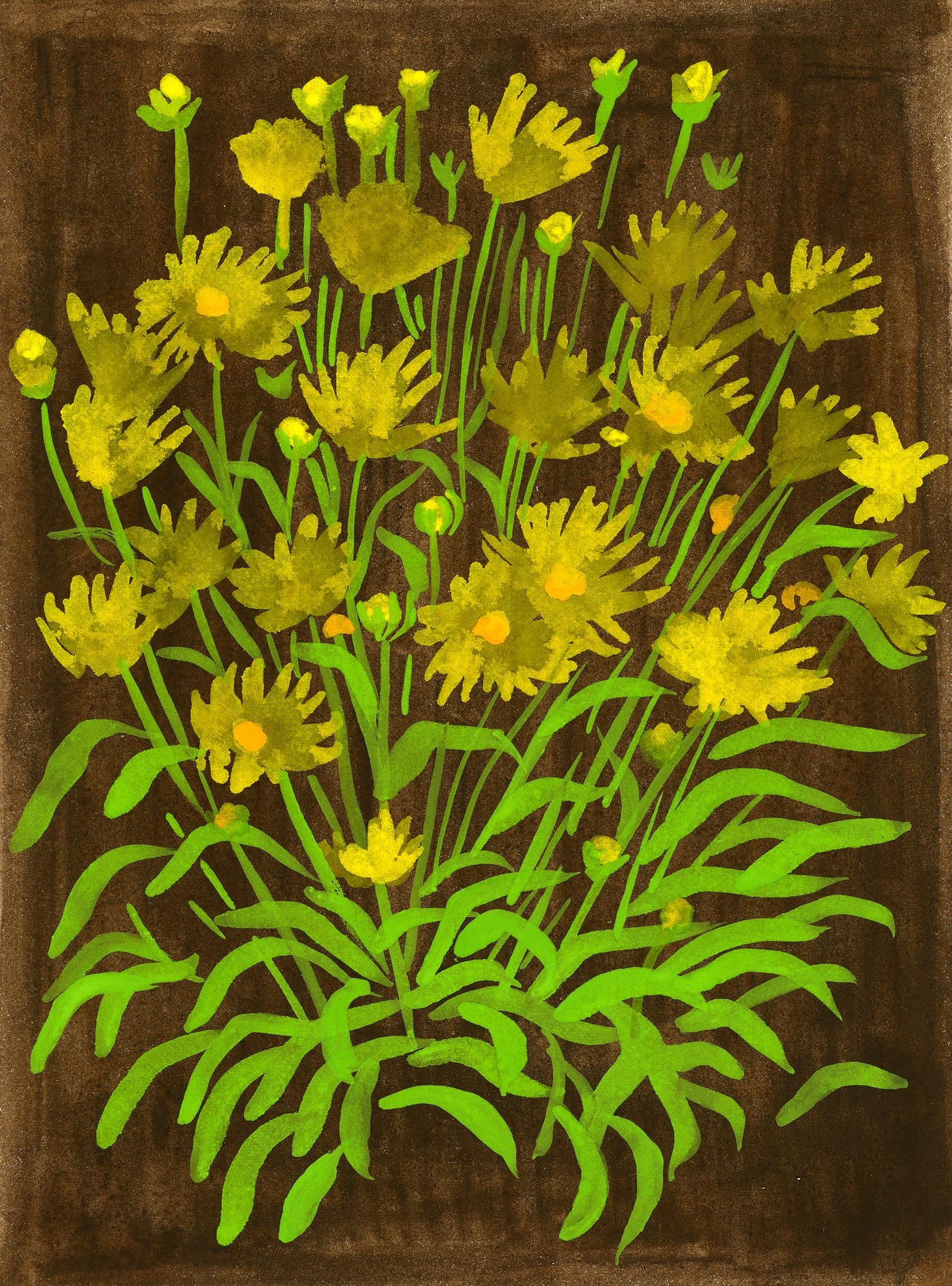Hi, friends — the bugs are out in force, so I decided it is a week for wasps. The yellowjacket (Vespula maculifrons) is pretty in yellow and black, and last summer I learned to appreciate them. So, here goes, a small ode to the stingers. As always, please hop in with your comments and stories. — AJP
Let’s take a moment in praise of wasps—stay with me while I explain. We’ve all been stung before, and it’s a sharp, effective, tiny needle of a sting that is surprisingly strong and long lasting. The wasp flies away, no bother, after dealing its blow, moving in a zigzag fashion. To me it looks as if it’s wagging a finger or making fun.
Wasps appear in places we don’t expect: in tight corners on porches; under picnic tables; snug in an umbrella (this happened to me); building nests in garages, under canoes, on the edges of lawns, unseen. If you look up “yellowjacket” online, you get an array of pest-control companies. We don’t share any love for wasps, a social insect, not terribly unlike honeybees.
Wasps occupy another world of the uncontrollable wild, and perhaps our distaste stems from our inability to tame or take anything from them. They seem to have the upper hand in this relationship, as evidenced by the many knuckles on which they’ve left their mark.
Last summer, I found a yellowjacket nest under a spray of yellow coreopsis flowers near our house. I discovered it while watering the coreopsis during a dry spell in mid-July. A dozen wasps flew out, slightly confused, wondering where this sudden rain was coming from. Thankfully they did not realize it was from me, and I found their wobbly, almost bumbling aerobatics rather amusing.
For the rest of the summer, I kept a wide berth and watched them from a few feet away. The entrance to their nest was a simple hole in the earth, a couple of inches across, with a smooth stone along the bottom. They seemed to use the stone as if it were a landing and take-off pad at a busy heliport. I found their rhythmic to-ing and fro-ing comforting. They landed and then disappeared into their underground lair, a place I will never know, and that’s okay with me. I was happy for the small glimpse they afforded me of their prodigious industry.
Yellowjackets are organized around a queen who creates a whole civilization from scratch. Each spring, a new queen determines a nesting site. She creates the first bit of nest, chewing wood to make pulp with her saliva (the nests are therefore a kind of literal papier-mâché). The queen then lays the first eggs and protects and cares for the larva until they reach adulthood and can help with the many chores.
The wasp queen continues to lay eggs and the colony can grow to thousands of individuals. As the nest expands, the female workers carve out space by removing dirt. I like the thought of them moving tiny bits of dirt here and there, rearranging the earth for themselves.
The nest under the coreopsis is gone now, having died out last fall. I’ve wondered about digging it up, to see what’s there. But I also like the idea of leaving things alone, a secret paper home held underground. Before dying, the nest nurtured new queens that made their trailblazing way out into the world. After hibernating over winter, they began their own civilizations from scratch, somewhere else. (I’ll probably find out where in about a month, when they’re really out and about.)
Wasps are incredibly important to ecosystems. They help pollinate flowers while searching for sugars. Fun fact—they enjoy honeydew (the sticky liquid secreted by aphids), but fermented honeydew can make them drunk. Most importantly, wasps hunt insects that can be harmful to plants and agriculture, feeding on the larvae of flies and moths, for example.
Yellowjackets help control insect populations and are therefore one of the more remarkable pest-control systems of the natural world. For this (and their striking yellow-and-black markings), I speak in praise of yellowjackets—from at least a few feet away.
Yellowjacket links—
Quick tip: If you encounter a yellowjacket, do not swat at it or try to squish it. This will only exacerbate her fight instinct, releasing pheromones to summon her friends for backup. They’re most active in late summer, so that’s when to keep your sticky picnics and fruity beverages wrapped up as much as possible.
I really wanted to see what a hive looks like and this video shows all the crazy life stages. Insects are cool. [ScienceOnline via YouTube]
It’s National Pollinator Week and this is a great opinion piece in the NYTs by one of my favorite writers Margaret Renkl.
Animal encounters in recent comments—
I like the thought of these pileated woodpeckers acting like a cuckoo clock, with thanks to Grace, plus giant baby woodpeckers (giant baby woodpeckers!) thanks to Karen.
Lots of cool animals sightings this month: pronghorn in Utah, western tanagers in Idaho and Colorado, black skimmers in North Carolina, plus bobcats, turkeys, raccoons, nutria, dolphins, ruddy ducks, and herons. Thanks to everyone for sending in their stories; take a look and add yours here. I’ll keep this thread open for the summer, so please keep an eye out.
Also—
Next time: I’m still thinking about bobcats. Any tips please let me know.
Thanks to everyone for supporting this newsletter adventure over the past seven months, and to everyone who has bought drawings. I’ve donated part of the proceeds to some very cool organizations: River Otter Ecology Project, International Wolf Center, Owl Research Institute, Cornell Lab of Ornithology, Clean Air Taskforce, Save the Snakes, The Amphibian Foundation.
Wild Life #26 / this newsletter is a place to learn about the life around us, one small step/paw/tiny heartbeat at a time. Thanks for reading and sharing with friends and family. Have a great weekend and see you in a couple of weeks.






I loved every beautiful word! thank you Amy Jean!!
I learned to live with yellowjackets at my previous house where I had a large vegetable garden. They were always around, and seemed to really appreciate the water that was available to them. I left them to their own devices and never once got stung. One moment that won me over was when they swarmed in and devoured a caterpillar nest on a tree - it didn't take long to eat them up!
What I won't tolerate is them building nests in/on the house. Twice we've seen them attempting to make use of odd holes in the siding. Duct tape over the hole puts an end to that.